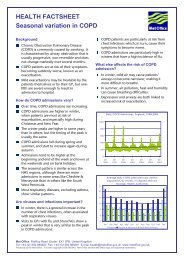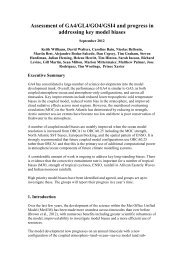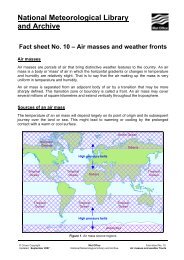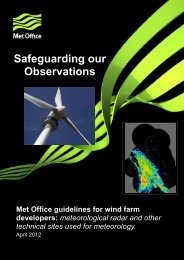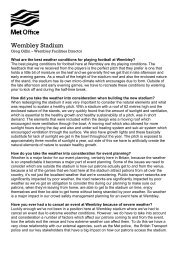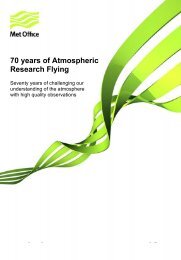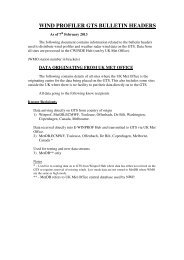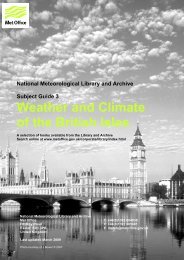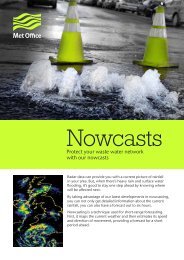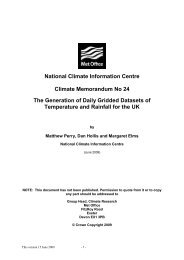Fact sheet 15 (PDF, 4 MB) - Met Office
Fact sheet 15 (PDF, 4 MB) - Met Office
Fact sheet 15 (PDF, 4 MB) - Met Office
Create successful ePaper yourself
Turn your PDF publications into a flip-book with our unique Google optimized e-Paper software.
How does radar work?Radar is an echo-sounding system, which uses the same aerial for transmitting a signal and receiving thereturned echo.Returning echoesRadarTransmitted pulse of electro-magnetic wavesPrecipitationFigure 2. How radar works.Short pulses of electro-magnetic waves, which travel at the speed of light (approx. 186000 miles persecond), are transmitted in a narrow beam for a very short time (typically 2 microseconds).When the beam hits a suitable target, some of the energy is reflected back to the radar, which ‘listens’ outfor it for a much longer period (3300 microseconds in the case of <strong>Met</strong> <strong>Office</strong> radars) before transmittinga new pulse. The distance of the target from the transmitter can be worked out from the time taken by apulse to travel there and back.The range and power of a radarSince radars cannot send and receive at the same time, the transmitted pulse must be very short (orechoes from close range will be lost), and the listening time must be as long as possible, for detectingdistant echoes. Increasingly the transmitted power is subject to engineering constraints and cost.A longer transmission pulse would give more power and better long-range performance, but wouldreduce the close-range capability.The returning echo is very much weaker than the transmitted pulse, and depends on several factors.There is attenuation, or absorption of energy, by particles of dust or cloud droplets in the atmosphere.There is also an inverse square relationship with range (i.e. doubling the range cuts the return power toone quarter) due to the increasing spread of the radar beam. The beam width of many modern radars isapproximately 1° and, as the target distance increases, only an increasingly small part of the transmittedbeam is reflected back to the radar.
Location of radars across the British IslesSite Name National Grid Reference Latitude Longitude LocationEastingsNorthingsClee Hill 359485 277940 52°23’53”N 002°35’49”W Titterstone Clee, near Ludlow,ShropshireHameldon Hill 381060 428740 53°45’17”N 002°17’19”W Dunnockshaw, nearBurnley, LancashireChenies 501642 199959 51°41’21”N 000°31’50”W Flauden, near Amersham,HertfordshireCastor Bay 119112 520302 54°30’00”N 006°20’24”W Near Lurgan, Belfast,Northern IrelandPredannack 169185 016440 50°00’12”N 005°13’21”W Near Ruan Major, The Lizard,CornwallIngham 496045 382975 53°20’06”N 000°33’33”W Ingham, near Lincoln,LincolnshireCrug-y-Gorllwyn 232190 234085 51°58’47”N 004°26’41”W Near Capel Iwan,Carmarthen, CarmarthenshireHill of Dudwick 397925 837835 57°25’51”N 002°02’10”W Near Ellon, AberdeenshireDruim a’Starraig <strong>15</strong>4395 932345 58°12’40”N 006°10’59”W Near Stornaway, Isle of LewisCobbacombeCross298080 119230 50°57’48”N 003°27’10”W Huntsham, near Tiverton,DevonThurnham 581670 <strong>15</strong>8290 51°17’41”N 000°36’<strong>15</strong>”E Near Maidstone, KentDean Hill 424335 125730 51°01’50”N 001°39’16”W Near West Dean, Salisbury,WiltshireHolehead 261790 682835 56°01’06”N 004°13’08”W Holehead, near Fintry, StirlingMunduff Hill 318820 703225 56°12’53”N 003°18’38”W Near Kinnesswood,Glenrothes, FifeHigh Moorsley 433873 545572 54°48’20”N 001°28’32”W Near DurhamJersey - - 49°12’34”N 002°11’56”W La Moye, JerseyChannel IslandsDublin 117207 400906 53°25’44”N 006°<strong>15</strong>’31”W Dublin Airport, IrelandShannon - - 52°42’01”N 008°55’24”W Shannon Airport, CountyClare, IrelandTable 1. Current radar locations.Proposed new rainfall radar sites in the British IslesSite Name National Grid Reference Latitude Longitude LocationEastingsNorthingsOld Buckenham 608500 293500 52°29’58”N 001°04’13”E Near Carleton Rode,Attleborough, NorfolkTable 2. Proposed additional radar locations.
Radar transmitter/receiverOn-site computerStand-by generatorFigure 4. View of the internal workings of a weather radar.Figure 5. Weather radar,Stornoway, Isle of Lewis.Figure 6. Weather radar,Chenies, Hertfordshire.Figure 7. Weather radar,Dean Hill, Wiltshire.
At each radar location an on-site computer carries out aerial elevation control and digital signal processing.The raw data is then sent to the Radarnet IV Central Processing at Exeter where the following processingis carried out:• Correction for attenuation by intervening rain• Correction to range attenuation• Elimination of ground clutter• Conversion of radar reflectivity to rainfall rate• Conversion from polar cells to National Grid Cartesian cellsThe radar network is then linked to a central computer at the <strong>Met</strong> <strong>Office</strong> Headquarters in Exeter. Eachradar is owned by a consortium of agencies, such as the Environment Agency, with the <strong>Met</strong> <strong>Office</strong>providing the technical and operational support.Each radar completes a series of scans about a vertical axis between four and eight low-elevation anglesevery 5 minutes (typically between 0.5 and 4.0 degrees, depending on the height of surrounding hills).Each scan gives good, quantitative data (1 and 2 km resolutions) out to a range of about 75 km and usefulqualitative data (5 km resolution) to 255 km.• 5 km resolution data provides a good overall picture of the extent of precipitation at a national/regionalscale.• 2 km data coverage extends over 85% of England and Wales and shows more detailed distribution ofprecipitation intensities. It is suitable for more demanding rainfall monitoring and hydrologicalapplications.• 1 km resolution provides the most detailed information, down to the scale of individual convectiveclouds. It is designed to assist real-time monitoring of small urban catchments and sewer systems.The radar image displayed gives the rainfall rate in nine colour intensity bands.0 – 0.25 mm per hour0.25 – 0.5 mm per hour0.5 – 1.0 mm per hour1 – 2 mm per hour2 – 4 mm per hour4 – 8 mm per hour8 – 16 mm per hour16 – 32 mm per hour>32 mm per hourTable 3. Rainfall intensity colour bands.This data provides valuable information for the immediate emergency response and the longer termplanning of future risk management and mitigation.
Below is a set of radar images from the Chenies Rainfall Radar, all from the same time and for the samearea, but at 5, 2 and 1 km horizontal resolutions. They show instantaneous rainfall rates, but withincreasing horizontal resolution, and this shows some intense rainfall cells between Dunstable andStevenage that only become identifiable in the higher resolution image.Figure 8.5 km resolution.Figure 9.2 km resolution.Figure 10.1 km resolution.
Doppler radarDepending on the equipment installed it is possible to obtain direction and speed information on thedroplets observed. Using this data it is then possible to calculate wind speed and elevation data withinthe rain cloud, out to a range of 100 km from the radar. This data is then used, amongst others, by the<strong>Met</strong> <strong>Office</strong>’s Numerical Weather Prediction team with the ultimate aim of improving the numerical modelthat is used to forecast the weather; this in turn increases the accuracy of the forecasts that are issued.Doppler radar used by the <strong>Met</strong> <strong>Office</strong> is still in its experimental stage but the sites currently equippedwith Doppler radar are:•4 Druim a’Starraig•4 Hill of Dudwick•4 Clee Hill•4 Holehead•4 Thurnham•4 Cobbacombe Cross•4 Dean HillThe way Doppler radar works is that two pulses of electromagnetic radiation are transmitted. The firstpulse is sent from the radar and the returning echoes are received, then almost immediately, a secondpulse is sent from the radar and again the returning echo is received. The computer then analysesthese two returned echoes and the movement of the droplets of water is calculated. This movementis only very slight but it is enough to calculate the wind speed within the cloud and the direction ofthe water droplets.8Cobbacombe642000 01 020203 04 05 06 07 08 09 10 11 12 13 14 <strong>15</strong> 16 17 18 19 20 21 22 23November2009Time UTCFigure 12. Wind profile generated by the Cobbacombe Cross Doppler radar.
Interpreting radar imageryThe radars do not receive echoes from tiny cloud particles, but only from the precipitation-sized droplets.Drizzle is generally too small to be reliably observed, unless close to the radar, but rain, snow and hail areall observed without difficulty.It is important to interpret the radar imagery in terms of the beam’s elevation and ‘width’ and the earth’scurvature. The latter, for example, means that echoes come from an increasingly higher level the furtheraway precipitation is from the radar. Thus at a range of 100 km, the radar beam is being reflected from theraindrops in a cloud at a height of 1.5 km, but beneath that level rain may be falling from the cloud whichthe radar misses. For this and other reasons (listed below), the radar rainfall display may not fully representthe rainfall observed at the ground.Non-meteorological echoes•4 Permanent echoes (occultation)These are caused by hills or surface obstacles blocking the radar beam, and are often referred to as clutter.Clutter is rarely seen on radar imagery as it can be mapped on a cloudless day, and then taken out orsubsequent pictures by the on-site computer.Figure 13. Non-meteorological echoes – permanent echoes caused by buildings etc.Figure 14. Clee hill radar display showing a breakin the beam (occulation) caused by the CambrianMountain in Wales.
Occultation is caused by the radar beam being obstructed by a hill or building. A network of overlappingradars helps to minimise this problem.•4 Spurious echoesThese may be caused by ships, aircraft, sea waves, chaff in use on military exercises, technical problems orinterference from other radars. The pattern formed by spurious echoes are short-lived, and can usually beidentified as they look very different from genuine precipitation echoes.Figure <strong>15</strong>. Non-meteorological echoes – spurious echoes caused by chaff used in military exercises.<strong>Met</strong>eorological causes of errors•4 Radar beam above the precipitation at long rangesFigure 16. <strong>Met</strong>eorological causes of errors – radar beam above the precipitation at long distances.
Even with a beam elevation of only 1°, an individual radar may not detect low-level rain clouds at longdistances. A network of overlapping radars helps to minimise this problem.•4 Evaporation of rainfall at lower levels beneath the beamFigure 17. <strong>Met</strong>eorological causes of errors – evaporation of rainfall at lower levels beneath the beam.Precipitation detected by the radar at high levels may evaporate if it falls through drier air nearer theground. The radar rainfall display will then give an over-estimate of the actual rainfall.•4 Orographic enhancement of rainfall at low levels.The rather light precipitation which is generated in layers of medium-level frontal cloud can increase inintensity by sweeping up other small droplets as it falls through moist, cloudy layers at low levels.This seeder-feeder mechanism is very common over hills, resulting in very high rainfall rates andFigure 18. <strong>Met</strong>eorological causes of errors – orographic enhancement of rainfall at low levels.
accumulations. Even with a network of radars, the screening effect of hills can make the detection of thisorographic enhancement difficult, resulting in an under-estimate of the actual rainfall.•4 Bright bandRadar echoes from both raindrops and snowflakes are calibrated to give correct intensities on therainfall display. But at the level where the temperature is near 0° C, melting snowflakes with large, wet,reflective surfaces give strong echoes. These produce a false band of heavier rain, or bright band, on theradar picture.0° CFigure 19. <strong>Met</strong>eorological causes of errors – bright band.•4 Drop sizes of precipitation within a cloudEvery cloud has a different composition of droplets; in particular, frontal rainfall clouds differ fromconvective shower clouds. In deriving rainfall rates from radar echo intensities, average values for cloudcompositions are used. Radars under-estimate the rain from clouds composed of smaller-than-averagedrops (e.g. drizzle), and over estimate the rain falling from clouds with very large drops (e.g. showers).DrizzleShowersFigure 20. <strong>Met</strong>eorological causes of errors – drop size of precipitation.
However, averaging the rain over 5 km squares on the radar rainfall display reduces the peak intensities inconvective cells.•4 Anomalous propagation (anaprop)Radar beams are like light beams, in that they travel in straight lines through a uniform medium but willbe bent (refracted) when passing through air of varying density. When a low-level temperature inversionexists (see fact <strong>sheet</strong> number 13 – Upper Air Observations and The Tephigram), the radar beam is bentdownwards and strong echoes are returned from the ground, in a manner akin to the formation ofmirages. This usually occurs in anticyclones, where rain is unlikely and so anaprop is normally recognisedwithout difficulty.Radar beam bent bythe temperaturedifferences in the airLow-leveltemperatureinversionTemperaturefalling with heightTemperaturerising with heightFigure 21. <strong>Met</strong>eorological causes of errors – anomalous propagation (anaprop).Advantages and disadvantages of weather radarAdvantages:•4 Detailed, instantaneous and integrated rainfall rates•4 Areal rainfall estimates over a wide area•4 Information in near-real time•4 Information in remote land areas and over adjacent seas•4 Location of frontal and convective (shower) precipitation•4 Monitoring movement and development of precipitation areas•4 Short-range forecasts made by extrapolation• Data can be assimilated into numerical weather prediction modelsDisadvantages:• Display does not show rainfall actually at the surface• Display also shows non-meteorological echoes• Estimates liable to error due to technical and meteorological related causes
The midday satellite image shows a deep andwell developed area of low pressure centred inthe western English Channel between Brest andPlymouth. The image shows clearly the cloudstructure swirling around the centre with bandsof rain and also some quite heavy and blusteryshowers. The main frontal zone can be seen fromsouth of Ireland extending across Scotland to theNorth Sea then across the continent to the westernMediterranean.Figure 23. Visible satellite image for 1200Z on2 December 2005.The 1255z radar image shows the swirl ofprecipitation associated with a deep depressioncentred in the western English Channel betweenBrest and Plymouth. This image shows clearly thefrontal rain across Scotland and Ireland as well asthe showery activity swirling around the centre ofthe depression.Figure 24. United Kingdom 5 km radar imagerycomposite for 1255Z on 2 December 2005.The 1255z Predannack radar image shows theswirl of precipitation associated with a deep anda well developed area of low pressure centred inthe western English Channel between Brest andPlymouth.Figure 25. Predannack 5 km radar imagery for1255Z on 2 December 2005.
The midday surface chart of the British Isles shows a deep area of low pressure in the western EnglishChannel with its associated occluded frontal system wrapped around it. Also depicted on this chart is awarm front across the western part of Scotland and into Northern Ireland and a trailing cold front lyingfrom Northern Ireland, through Dumfries and Galloway, Cumbria, across the Pennines and down throughEast Yorkshire and away into the North Sea and onwards into the near continent. Following on behind thiscold front is a trough running from North Wales, across the Midlands and Southeast England then awayinto Northern France.Figure 26. <strong>Met</strong> <strong>Office</strong>’s Operations Centre analysis chart for 1200Z on 2 December 2005.
This fact <strong>sheet</strong> has been produced in conjunction with the <strong>Met</strong> <strong>Office</strong>’s Observation Networks remotesensing section.For more information about Remote Sensing, please contact the <strong>Met</strong> <strong>Office</strong> Customer Centre on:Tel: 0870 900 0100Fax: 0870 900 5050Email: enquiries@metoffice.gov.ukIf you are outside the UK:Tel: +44 (0)1392 885680Fax: +44 (0)1392 885681All of the images used in this fact <strong>sheet</strong> along with many others covering all aspects of meteorology can beobtained from the National <strong>Met</strong>eorological Library.For more information about what images are available, please contact the Library Information <strong>Office</strong>r at:Tel: 01392 884845Email: metlib@metoffice.gov.uk
Other Titles in this series still available are:• Number 1 Clouds• Number 2 Thunderstorms• Number 3 Water in the Atmosphere• Number 4 Climate of the British Isles• Number 5 White Christmases• Number 6 The Beaufort Scale• Number 7 Climate of Southwest England• Number 8 The Shipping Forecast• Number 9 Weather Extremes• Number 10 Air Masses and Weather Fronts• Number 11 Interpreting Weather Charts• Number 12 National <strong>Met</strong>eorological Archive• Number 13 Upper Air Observation and The Tephigram• Number 14 Microclimates• Number 16 World climates• Number 17 Weather observations
Our unique collection of weather images is now available via the National <strong>Met</strong>eorological Libraryand Archive’s online catalogue.The collection illustrates all aspects of meteorology, from clouds and weather phenomena, toinstruments and the work of the <strong>Met</strong> <strong>Office</strong>. Our online catalogue can be found at:www.metoffice.gov.ukAll of the fact <strong>sheet</strong>s in this series are available to download from the <strong>Met</strong> <strong>Office</strong>’s website.The full list can be found at:www.metoffice.gov.uk/learning/library/publications/fact<strong>sheet</strong>s<strong>Met</strong> <strong>Office</strong>FitzRoy Road, ExeterDevon, EX1 3PBUnited KingdomTel: 0870 900 0100Fax: 0870 900 5050enquiries@metoffice.gov.ukwww.metoffice.gov.ukProduced by the <strong>Met</strong> <strong>Office</strong>.© Crown copyright 2009 09/0282<strong>Met</strong> <strong>Office</strong> and the <strong>Met</strong> <strong>Office</strong> logoare registered trademarks



